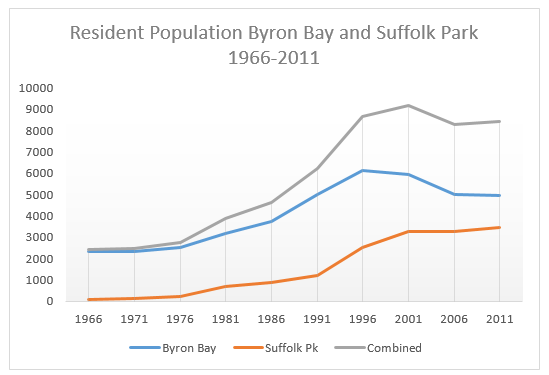Site 5: Byron Bay Development
PREV NEXT
Although there is a record of a single dwelling in the Byron Bay area in 1882, the town was only laid out in 1884 with the first lots sold in July 1886. It was officially declared a town on 28 August 1896.
An influx of farmers, labourers and merchants followed the development of the “old” jetty in 1888, the opening of the railway in 1894 and the building of NORCO’s butter factory in 1895. The town’s population grew rapidly and roughly as its industries developed but stabilised between 2,300 and 2,600 from the end of WW1 to 1971. This half century was Byron Bay’s industrial era when it was unkindly described as a town “reeking with the stench from the piggery, meatworks, whaling factory and sand processing with their effluent colouring the sea and washing on the shore”. All of Byron Bay’s industries had closed by 1975, except the meat works. Cheap houses, clearer air and cleaner seas attracted new people to town.
The two decades between 1976 and 1996 were the “great growth years” for Byron Bay with its population jumping from 2,764 to 8,658. New subdivisions were developed to accommodate demand. The Industrial and Arts Estate of 50 acres was opened for development in 1972 and the nearby Sunrise Beach residential area opened soon after. The “Sandhills” sub-division was opened in 1974 in the area behind Main Beach between Middleton and Massinger Streets. The first land release in the Pacific Vista Estate was made in 1980. Suffolk Park’s boom started in the mid 1970’s with the number of residents jumping 184% in the five years from 1976.

In the twenty years from 1976 the demographics of the Byron Bay changed fundamentally. Industrial workers were replaced by those in the service industries, particularly tourism, and those who sought beach or bush lifestyles. The remaining locals, the newly-arrived surfers, hippies, environmentalists and those looking for a peaceful and beautiful place to live all valued the natural assets and beauty of the area. They understood that the town and its hinterland needed assistance and time to recover.
Byron Bay’s population continues to grow in the 21st century but more slowly.